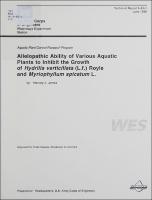Please use this identifier to cite or link to this item:
https://hdl.handle.net/11681/6380Full metadata record
| DC Field | Value | Language |
|---|---|---|
| dc.contributor.author | Jones, Harvey L. | en_US |
| dc.creator | Aquatic Plant Control Research Program (U.S.) | en_US |
| dc.creator | U.S. Army Engineer Waterways Experiment Station | en_US |
| dc.date.accessioned | 2016-03-23T19:55:10Z | en_US |
| dc.date.available | 2016-03-23T19:55:10Z | en_US |
| dc.date.issued | 1995-06 | en_US |
| dc.identifier.govdoc | Technical Report A-95-1 | en_US |
| dc.identifier.uri | http://hdl.handle.net/11681/6380 | en_US |
| dc.description | Technical Report | en_US |
| dc.description.abstract | Allelopathy refers to the biochemical interactions that take place among plants, but its effectiveness depends on the addition of a chemical to the environment. In general, the term allelopathy refers to the detrimental effects of higher plants of one species (the donor) on the germination, growth, or development of another species (the recipient). A more functional definition is any direct or indirect harmful effect by one plant (including microorganisms) on another through production of chemical compounds that escape into the environment. Allelopathy is a potentially important tool in controlling undesirable nuisance aquatic weed problems. Various studies have shown that some plants have the capability of eradicating other species in the same area; however, most of these studies have been conducted in using terrestrial plants or plants located in the littoral zone of aquatic habitats. There are only a few studies that show the allelopathic effects of submersed aquatic hydrophytes. Hydrilla and myriophyllum grown (from axenic cultures) were placed in test tubes for 2 weeks at a constant water bath temperature of 25°C. Test tubes were randomly selected to receive 1 of 10 aquatic plant extracts. The extract was applied to a test tube with a 2-cm explant of the target plant (Hydrilla verticillata or Myriophyllum spicatum), grown for 14 days, harvested, measured, dried at 70° C, and weights recorded. The biomass of Hydrilla verticillata and Myriophyllum spicatum were significantly reduced by Ceratophyllum demersum extracts when compared with the controls. In separate studies, a 15-cm sprig of Hydrilla or Myriophyllum was grown in 12-𝓁 capacity acrylic columns with an additional 5- or 20-percent aquatic plant organic mauer added to the sediment, filled with growth media, then placed in a 1,200-𝓁 water bath at a constant temperature of 25°C. Results show that when 20-percent organic matter was added to the sediment, Ceratophyllum demersum significantly reduced the growth of hydrilla and myriophyllum; however at 5 percent, Ceratophyllum acted as a stimulant. All data were analyzed using ANOVA and the Duncan's Multiple Range Test in SAS. | en_US |
| dc.description.sponsorship | Aquatic Plant Control Research Program (U.S.) | en_US |
| dc.description.sponsorship | United States. Army. Corps of Engineers | en_US |
| dc.description.tableofcontents | Preface..........................iv 1-Introduction..........................1 Background..........................1 Importance of Allelopathy..........................2 Pertinent Literature Review..........................3 Allelopathic potential studies..........................3 Studies of plant growth inhibitors and organic compounds..........................4 Objectives..........................5 2-Methods and Materials..........................7 Plant Collection..........................7 Test Species Selection..........................7 Stock Hydrilla Cultures..........................7 Extract Preparation..........................7 Experiment 1..........................8 Experiment 2..........................10 Data Analyses..........................10 Test-tube assays for hydrilla and myriophyllum..........................10 Tank studies for hydrilla and myriophyllum..........................12 3-Results and Discussion..........................14 4-Conclusion..........................16 References..........................17 SF 298 | en_US |
| dc.format.extent | 27 pages/4.24 MB | en_US |
| dc.format.medium | en_US | |
| dc.language.iso | en_US | en_US |
| dc.publisher | U.S. Army Engineer Waterways Experiment Station | en_US |
| dc.relation | http://acwc.sdp.sirsi.net/client/en_US/search/asset/1042411 | en_US |
| dc.relation.ispartofseries | Technical Report (Aquatic Plant Control Research Program (U.S.)) ; no.Technical Report A-95-1 | en_US |
| dc.rights | Approved for public release; distribution is unlimited | en_US |
| dc.source | This Digital Resource was created from scans of the Print Resource | en_US |
| dc.subject | Allelopathy | en_US |
| dc.subject | Hydrilla verticillata | en_US |
| dc.subject | Myriophyllum spicatum | en_US |
| dc.subject | Eurasian watermilfoil | en_US |
| dc.subject | Hydrilla | en_US |
| dc.subject | Biological control | en_US |
| dc.subject | Biocontrol | en_US |
| dc.subject | Aquatic Plant Control Research Program (U.S.) | en_US |
| dc.title | Allelopathic ability of various aquatic plants to inhibit the growth of Hydrilla verticillata (L.f.) Royle and Myriophyllum spicatum L. | en_US |
| dc.type | Report | en_US |
| Appears in Collections: | Technical Report | |
Files in This Item:
| File | Description | Size | Format | |
|---|---|---|---|---|
| TR-A-95-1.pdf | Technical Report A-95-1 | 4.24 MB | Adobe PDF |  View/Open |